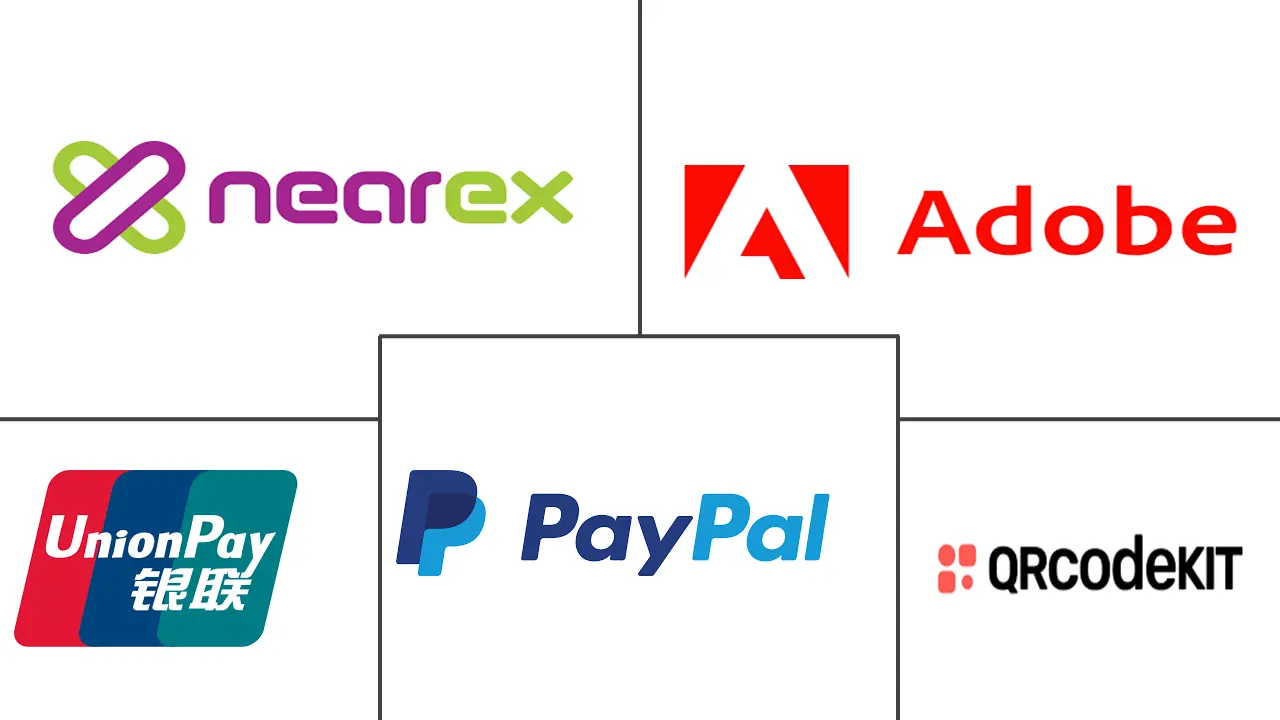QR Codes Market Size and Share
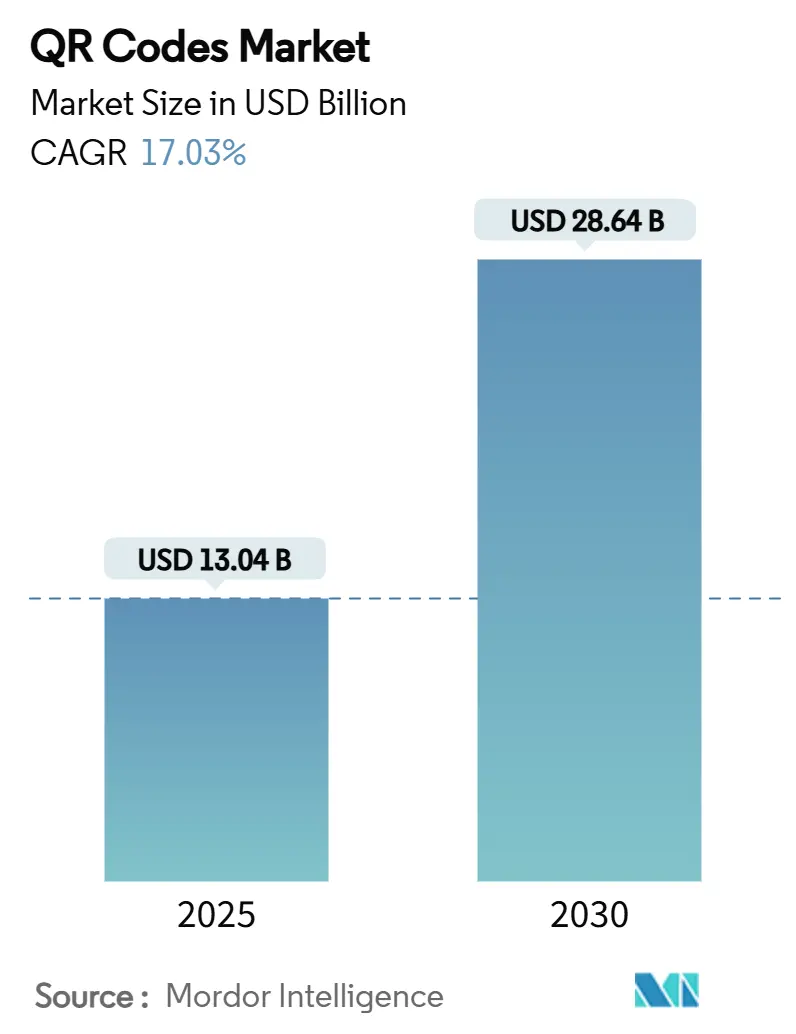
QR Codes Market Analysis by Mordor Intelligence
The QR code market is valued at USD 13.04 billion in 2025 and is projected to reach USD 28.64 billion by 2030, advancing at a robust 17.03% CAGR during 2025-2030. Continued momentum reflects the shift from experimental trials to enterprise-scale deployments that underpin digital payments, regulatory compliance, and data-driven marketing. Demand accelerates as merchants in every income bracket adopt contact-free checkout, regulators mandate serialized product identities, and brands prioritize first-party data capture amid cookie deprecation. Dynamic solutions have overtaken static formats, accounting for 65% of global implementations, and they now function as analytics gateways that guide omnichannel experiences. Asia-Pacific remains the growth engine, while Europe’s policy directives and North America’s marketing experimentation create parallel adoption narratives that broaden the addressable base. Competitive intensity rises as pure-play generators, payment networks, and software platforms bundle code creation, security, and vertical templates to win enterprise contracts.
Key Report Takeaways
- By format, dynamic codes led with 65% of the QR code market share in 2024 and are projected to expand at a 19.2% CAGR through 2030.
- By type, Website QR codes held 28% revenue share in 2024; App-Store QR codes are forecast to advance at a 21.1% CAGR to 2030.
- By payment type, push-payment flows captured 60% of the QR code market size in 2024, while pull-payment flows are expected to grow at 18.9% CAGR between 2025-2030.
- By application, Payments and Transactions dominated with 46% share of the QR code market size in 2024; Marketing and Advertising is positioned to expand at 19.5% CAGR through 2030.
- By geography, Asia-Pacific commanded 39% of the QR code market share in 2024 and posts the highest forecast CAGR at 18.3% for 2025-2030.
Global QR Codes Market Trends and Insights
Drivers Impact Analysis
| Driver | (~) % Impact on CAGR Forecast | Geographic Relevance | Impact Timeline |
|---|---|---|---|
| Exploding UPI & AliPay-Style QR Payments in Asia | +4.2% | Asia-Pacific, with spillover to Middle East and Africa | Medium term (2-4 years) |
| EU Digital Product Passport Mandate Fueling Embedded-QR Labelling | +3.1% | Europe, with global supply chain implications | Long term (≥ 4 years) |
| U.S. FDA DSCSA Serialization Deadline Boosting Pharma Traceability QR | +2.5% | North America, with global pharmaceutical industry impact | Medium term (2-4 years) |
| GCC Tourism Push Driving Multilingual QR Menu Adoption | +1.8% | Middle East, with influence on global hospitality standards | Short term (≤ 2 years) |
| GenAI-Led Personalized Dynamic QR Campaigns for Retail Loyalty | +2.7% | Global, with early adoption in North America and Europe | Medium term (2-4 years) |
| Carbon-Footprint Disclosure Labels (e.g., in Nordics) Switching to QR | +1.5% | Europe, with gradual global adoption | Long term (≥ 4 years) |
| Source: Mordor Intelligence | |||
Exploding UPI & Alipay-style QR payments in Asia
Asia’s mobile-first economies drive the QR code market as India’s UPI handled 81 trillion transactions between April and July 2024, a 37% jump year over year. China’s ecosystem processes over 90% of mobile payments via QR, underpinning USD 3,744 billion in value. Japan is coordinating with ASEAN members to enable reciprocal QR acceptance by 2025. Together these initiatives minimize interchange friction, letting even micro-merchants leapfrog card infrastructure. As similar templates spread to Africa and Latin America, a unified scan-to-pay paradigm threatens traditional cards and widens financial inclusion, reinforcing the QR code market’s growth runway.
EU Digital Product Passport mandate fueling embedded-QR labelling
Brussels’ Ecodesign for Sustainable Products Regulation, live since July 2024, requires every covered item to carry a scannable identifier linking to composition and impact data. Batteries must comply by 2026, with textiles and electronics to follow, spanning 30 categories by 2030. Because non-EU manufacturers must also meet the rules, the directive effectively globalizes QR-centric transparency. First movers already convert compliance investment into brand equity through verifiable sustainability claims, embedding long-life demand for dynamic codes that can update impact metrics without reprinting.
U.S. FDA DSCSA serialization deadline boosting pharma traceability
All prescription drugs distributed in the United States must carry a unit-level identifier by November 2024, elevating QR codes from optional to essential in the pharmaceutical supply chain. Serialization reduces counterfeiting risk, automates recall management, and opens a patient-communication channel via embedded leaflets and safety alerts. Global producers exporting to the U.S. are harmonizing packaging lines accordingly, spreading the standard across their worldwide operations. As firms integrate scan analytics into inventory systems, QR touchpoints become the backbone of real-time supply-chain visibility, increasing operational resilience and creating a durable pull on the QR code market.
GenAI-led personalized dynamic QR campaigns for retail loyalty
Dynamic codes now constitute 79% of B2B deployments. Coupled with generative AI, a single QR can trigger context-aware landing pages tailored by shopper profile, location, and past behavior. Retailers report 37% average click-through rates—far above email benchmarks—while simultaneously gathering permissioned first-party data that replaces cookie-based tracking. These performance gains justify larger marketing budgets and embed the technology within long-term customer-experience roadmaps, cementing the QR code market as a core pillar of data-driven growth strategies.
Restraints Impact Analysis
| Restraint | (~) % Impact on CAGR Forecast | Geographic Relevance | Impact Timeline |
|---|---|---|---|
| Deep-fake Phishing via Look-Alike QR Codes Hinders the Market | -2.1% | Global, with higher impact in North America and Europe | Medium term (2-4 years) |
| Fragmented National Standards (EMVCo vs. BharatQR vs. SG-QR) Restraints the Market Growth | -1.8% | Global, with particular impact on cross-border transactions | Long term (≥ 4 years) |
| Apple/Google Tap-to-Pay Cannibalizing Low-Value QR Transactions | -1.5% | North America and Europe primarily | Medium term (2-4 years) |
| GDPR & CCPA Limits on First-Party Data in Dynamic QR | -1.1% | Europe and North America, with global compliance implications | Medium term (2-4 years) |
| Source: Mordor Intelligence | |||
Deep-fake phishing via look-alike QR codes hinders adoption
“Quishing” attacks surged 587% year on year in 2024, now representing 20% of all online scams. Malicious actors exploit the fact that users cannot preview URLs before scanning, and only 39% of individuals recognize tampered codes. Executive impersonation is rampant, with senior leaders 42 times more likely to be targeted than rank-and-file staff. Enterprises are deploying secure scanner apps, encrypted tokens, and code-integrity seals, yet the persistent trust gap suppresses uptake in banking, healthcare, and other high-risk contexts, moderating the QR code market’s otherwise rapid trajectory.
Fragmented national standards restrain cross-border scalability
EMVCo, BharatQR, and SG-QR grew independently and share limited interoperability, forcing multinationals to run parallel systems that inflate costs and complicate reconciliation. Japan’s Ministry of Economy, Trade and Industry is brokering an integrated framework with ASEAN peers by 2025, but entrenched domestic interests slow harmonization. Until protocols converge, merchants, especially SMEs, face friction in serving tourists and cross-border shoppers, trimming expansion speed for the QR code market.
Segment Analysis
By Type: Website codes anchor reach while App-Store tags accelerate
Website tags accounted for 28% of the QR code market share in 2024, translating to the largest traffic-generation gateway for brands that need device-agnostic links to digital storefronts. Their staying power stems from universal camera support and the ability to refresh landing pages without changing media placements. App-Store codes, however, post a 21.1% CAGR to 2030, making them the fastest climber in the QR code market; publishers rely on scan-to-download journeys that trim friction and raise conversion rates by double digits. Hospitality-oriented Menu codes permeate 70% of U.S. restaurants, while File-Download and Social-Media variants service corporate training and influencer campaigns. Ecosystem players now bundle sector-specific analytics dashboards that relay scan location, daypart, and repeat behavior back to CRM systems, laying the foundation for real-time content optimization across every code family.
Cost considerations still influence deployment choices. Website tags remain the default for micro-firms that value free generators and minimal maintenance overhead. Conversely, growth-stage enterprises upgrade to dynamic App-Store or Menu formats that let them iterate offers without reprinting collateral. This flexibility explains why dynamic categories captured 65% of overall volume and are forecast to widen their lead. As AR overlays and device-resident wallets converge, cross-type functionality will blur, but mastery of context-aware content routing will decide which platforms capture disproportionate value within the QR code market.
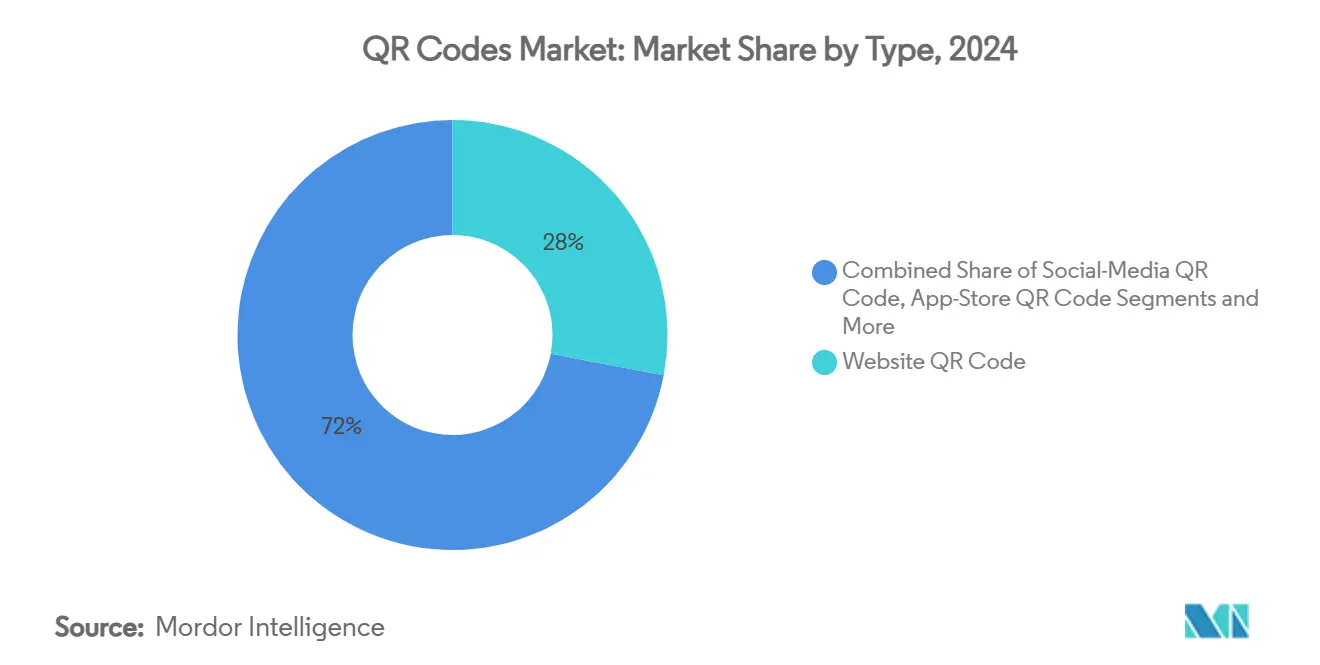
Note: Segment shares of all individual segments available upon report purchase
By Payment Type: Push remains dominant while pull narrows the gap
Push payments, where shoppers scan merchant-displayed codes, represented 60% of the QR code market size in 2024. The model’s low cost and instant settlement make it indispensable for corner shops and street vendors across emerging Asia. Alipay, WeChat Pay, and India’s UPI provide turnkey settlement rails, allowing merchants to transact without traditional terminals. Pull payments, where customers present personal codes, grow at an 18.9% CAGR as wallets like Google Pay and Apple Pay embed QR as a fallback for NFC-lean banking ecosystems. Pull flows excel at integrating loyalty points and post-transaction offers because the code originates in the consumer’s device, granting direct linkage to identity graphs and preference data.
Strategists observe convergence: Chinese wallets now support pull for P2P transactions, while U.S. acquirers issue dynamic merchant codes that convert to pull when shoppers use bank-branded apps. Hybrid orchestration engines unify settlement, rewards, and financing into a single QR encounter, letting acquirers upsell ancillary services. As cross-border frameworks mature, the ability to translate push and pull semantics on the fly will become a competitive necessity, reinforcing payment-layer stickiness and enlarging the QR code market.
By Format: Dynamic tags redefine lifecycle management
Dynamic variants dominated with 65% share in 2024, lifting the QR code market as companies embed reprogrammable surfaces on packaging, signage, and receipts. Enterprises value the capacity to swap promotions, languages, and compliance disclosures without re-stickering inventory, cutting print waste and accelerating campaign cycles. Scan events feed dashboards that visualize footfall, offline ROAS, and SKU-level engagement, closing traditionally elusive attribution loops. Static codes still serve pop-up events and one-off posters where lifespan is short and analytics optional, but cloud-linked dynamic tools secure larger enterprise contracts.
Innovation outpaces threat vectors. Providers integrate one-click security scores, geo-fencing, and AI anomaly detection to neutralize phishing. Conditional redirects now tailor content by device OS, time zone, or weather, all controlled from a single CMS. As these functions migrate into low-code marketing hubs, dynamic tags move from tactical assets to strategic infrastructure, ensuring the QR code market maintains double-digit expansion even as overall advertising budgets tighten.
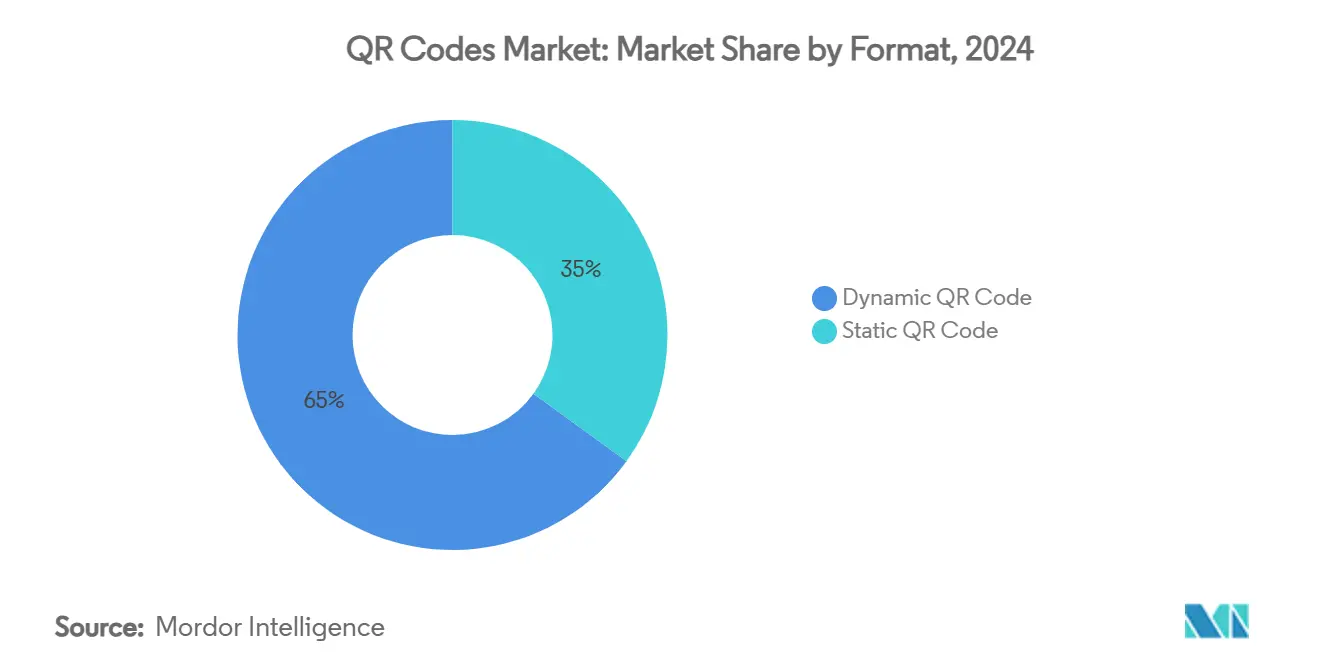
By End-User Application: Payments anchor revenue while marketing outpaces
Payments & Transactions delivered 46% of total revenue in 2024, solidifying the QR code market’s foothold in daily commerce. Scan-to-pay flows generated USD 50 billion in fee revenue worldwide, championed by markets where cards never achieved full penetration. Yet Marketing & Advertising, preparing for a cookieless web, accelerates at 19.5% CAGR through 2030. Brands embrace codes as measurable bridges that tie print, TV, and out-of-home to on-device journeys with 37% click-through performance, dwarfing banner norms. Information Sharing applications scale as regulators force richer disclosures onto minimal real estate, while Customer Engagement & Loyalty programs exploit scan data for instant enrollment and personalized rewards.
Convergence is the watchword. Leading quick-service chains knit payment, loyalty, and menu management behind a single table-top code, reducing tech-stack sprawl and amplifying customer insights. B2B suppliers add after-sales portals and field-service manuals behind serialized codes, squeezing out legacy portals. As every scan creates an actionable customer moment, the QR code market extends beyond transactions into lifelong relationship orchestration.
Geography Analysis
Asia-Pacific owned 39% of the QR code market share in 2024 and is projected to grow at 18.3% CAGR through 2030. China processes more than 90% of mobile payments via QR and recorded USD 437 million in consumer fee revenue last year, while India supports over 9 million merchant codes and saw UPI volumes climb 37% year on year. Regional governments pursue interoperability: Japan’s collaboration with ASEAN members will let tourists use home wallets abroad by 2025. Such policy cohesion accelerates adoption in transport, public utilities, and citizen services, embedding QR codes into daily life and reinforcing Asia’s status as the leading test bed for next-gen formats.
North America ranks second in revenue terms, led by the United States, which handled 43.9% of global scans in 2023 and will surpass 100 million users in 2025. Uptake leans toward marketing, loyalty, and healthcare authentication. The U.S. FDA DSCSA milestone compels pharmaceutical packagers to integrate serialized tags, while retailers exploit scan analytics to reconcile physical footfall with e-commerce carts. Although NFC remains strong, the QR code market grows as a versatile backup and as a conduit for opt-in data capture that complies with the California Consumer Privacy Act.
Europe’s growth curve is shaped by regulation and sustainability. The Digital Product Passport mandate primes multiple verticals—batteries in 2026, textiles soon after—for mandatory QR identifiers. Nordic supermarkets already print dynamic carbon labels that update in real time, setting consumer expectations for transparent disclosures. Payment standardization through Mobile Initiated SEPA Credit Transfers targets fragmentation and could accelerate consumer usage in a region where contactless cards dominate but QR codes show promise for bill-pay, invoices, and peer-to-peer remittances.
The Middle East and Africa show diverse trajectories. GCC hospitality groups deploy multilingual QR menus that lift table-turnover by 15%, aligning with national tourism visions. Saudi Arabia and the UAE back centralized QR rails to shrink cash usage, while Nigeria and South Africa adopt standardized specifications to prevent a patchwork of incompatible systems. Infrastructure gaps persist in rural areas, yet mobile-network penetration creates fertile ground for scan-based financial inclusion, extending the QR code market’s potential across socio-economic tiers.
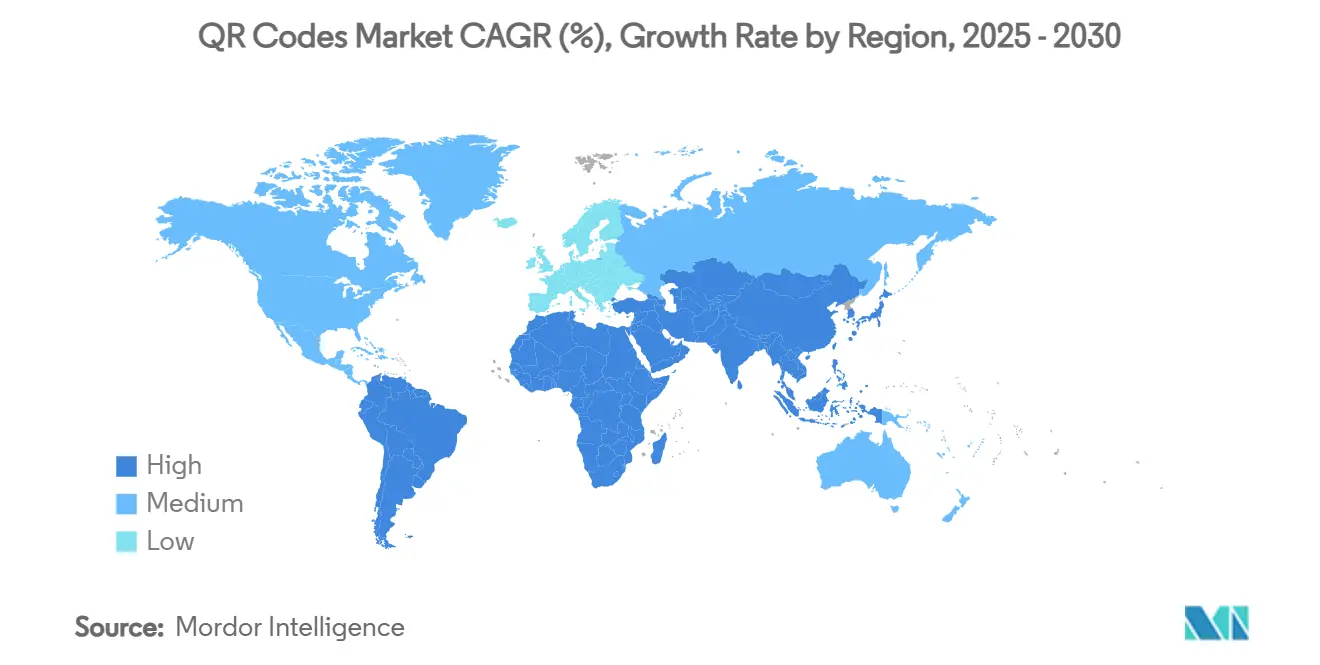
Competitive Landscape
The QR code market remains fragmented, with no single vendor exceeding a double-digit revenue share. Specialist generators—Uniqode, QR TIGER, Flowcode—differentiate through granular analytics, API openness, and industry-specific templates. Uniqode’s January 2024 rebrand underscores a shift toward enterprise-grade positioning, and its May 2025 report indicates that 59% of consumers now scan at least once daily. [1]Debayan Paul, “QR Code History—From 1994 to 2024—in Under 10 Mins,” Uniqode, uniqode.com Payment majors such as PayPal, Block, and UnionPay embed QR rails into wallets, safeguarding transaction relevance in regions that leapfrog mag-stripe cards. Global card networks Visa and Mastercard partner with acquirers to bundle scan acceptance at the terminal, hedging against declining swipe volumes.
Strategic moves intensify. Kezzler’s February 2025 acquisition of Scanbuy strengthens secure serialization know-how for pharmaceuticals and luxury goods. [2]John Adams et al., “Visa, Mastercard and Google Go Big in India,” American Banker, americanbanker.com Visa’s collaboration with HDFC Bank on compact hybrid devices targets micro-merchants in India, marrying point-of-sale resilience with scan convenience. [3]"Kezzler Expands Industry Leadership With Acquisition of Scanbuy,” Kezzler, kezzler.comQR Squared’s packaging-grade high-capacity codes respond to retailers’ demand for anti-counterfeit safeguards, positioning the firm at the intersection of traceability and consumer engagement.
Value-added services shape competitive advantage. Encryption-ready dynamic tags combat phishing, while AI-powered dashboards surface cohort behaviors that feed personalized offers within milliseconds. Vendors that unify code creation, campaign orchestration, and compliance reporting capture larger wallet share because procurement teams prefer single-pane control. Security remains a battleground: Mastercard’s biometric-passkey pilot intends to restore user trust eroded by quishing, illustrating how risk mitigation becomes a selling point. As GS1’s Sunrise 2027 shift from EAN to 2D symbologies approaches, suppliers able to map legacy barcodes to next-gen formats will enjoy a structural tailwind that consolidates volumes within the QR code market.
QR Codes Industry Leaders
-
PayPal Holdings, Inc.
-
UnionPay International Co., Ltd.
-
Nearex Pte Ltd.
-
QR Code Kit Inc.
-
Adobe Inc.
- *Disclaimer: Major Players sorted in no particular order
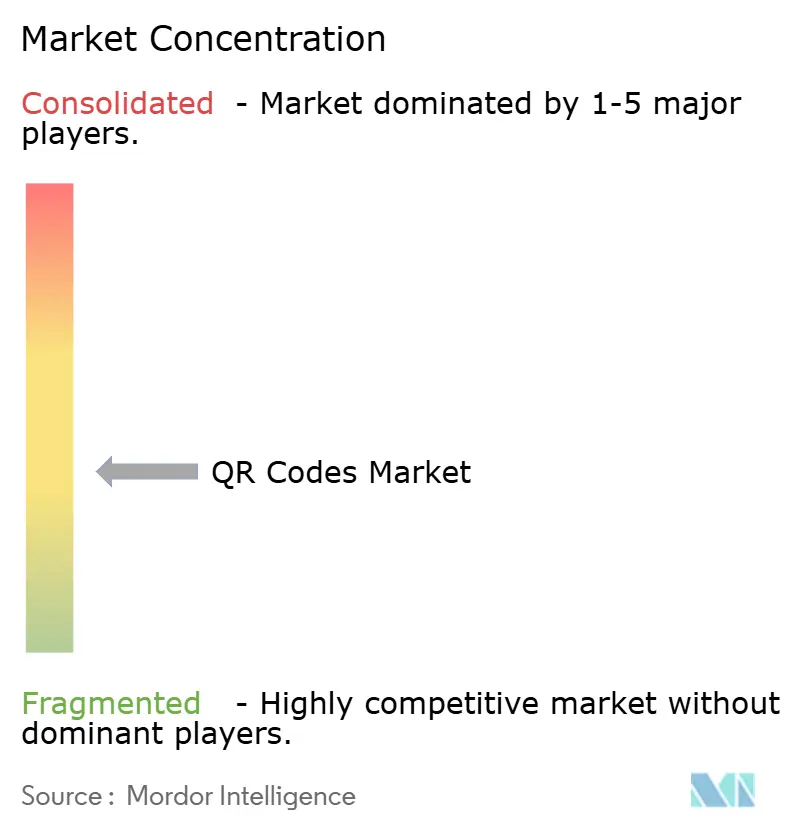
Recent Industry Developments
- May 2025: Uniqode released its "State of QR Codes 2025" report revealing that 59% of consumers scan QR codes daily and 95% of businesses report that QR codes help gather valuable first-party data, highlighting the technology's central role in customer engagement strategies as third-party tracking declines Uniqode.
- April 2025: Japan's Ministry of Economy, Trade and Industry announced a collaboration with ASEAN countries and India to enable mutual use of QR code payment services by 2025, coinciding with the Osaka World Expo, creating a unified payment ecosystem that eliminates currency exchange barriers for tourists and merchants Nikkei Asia.
- March 2025: The European Commission published detailed implementation guidelines for the Digital Product Passport initiative, mandating QR codes as the primary carrier for product information across 30 product categories by 2030, starting with batteries in 2026 followed by textiles and electronics info.link.
- February 2025: Kezzler expanded its industry leadership in the QR Code market by acquiring Scanbuy, strengthening its position in secure QR code solutions for product authentication and supply chain transparency Kezzler.
Global QR Codes Market Report Scope
The market is defined by the revenue generated from various types of QR codes, which are being used in static and dynamic formats in a diverse range of geographic regions worldwide.
The QR codes market is segmented by QR code type (website QR code, menu QR code, file download QR code, social media QR code, app store QR code, and others), by format (static QR code and dynamic QR code), by end-user application (marketing and advertising, payments and transactions, information sharing, customer engagement, and others), and by geography (North America, Asia-Pacific, Europe, Latin America, Middle East and Africa). The market sizes and forecasts are provided in terms of value (USD) for all the above segments.
| Website QR Code |
| Menu QR Code |
| File-Download QR Code |
| Social-Media QR Code |
| App-Store QR Code |
| Other Types |
| Push Payment |
| Pull Payment |
| Static QR Code |
| Dynamic QR Code |
| Payments and Transactions |
| Marketing and Advertising |
| Information Sharing |
| Customer Engagement and Loyalty |
| Other End-User Applications |
| North America | United States |
| Canada | |
| Mexico | |
| Europe | United Kingdom |
| Germany | |
| France | |
| Spain | |
| Rest of Europe | |
| Asia-Pacific | China |
| India | |
| Japan | |
| South Korea | |
| Rest of Asia-Pacific | |
| South America | Brazil |
| Argentina | |
| Rest of South America | |
| Middle East | Saudi Arabia |
| United Arab Emiartes | |
| Rest of Middle East | |
| Africa | South Africa |
| Nigeria | |
| Rest of Africa |
| By Type | Website QR Code | |
| Menu QR Code | ||
| File-Download QR Code | ||
| Social-Media QR Code | ||
| App-Store QR Code | ||
| Other Types | ||
| By Payment Type | Push Payment | |
| Pull Payment | ||
| By Format | Static QR Code | |
| Dynamic QR Code | ||
| By End-User Application | Payments and Transactions | |
| Marketing and Advertising | ||
| Information Sharing | ||
| Customer Engagement and Loyalty | ||
| Other End-User Applications | ||
| By Geography | North America | United States |
| Canada | ||
| Mexico | ||
| Europe | United Kingdom | |
| Germany | ||
| France | ||
| Spain | ||
| Rest of Europe | ||
| Asia-Pacific | China | |
| India | ||
| Japan | ||
| South Korea | ||
| Rest of Asia-Pacific | ||
| South America | Brazil | |
| Argentina | ||
| Rest of South America | ||
| Middle East | Saudi Arabia | |
| United Arab Emiartes | ||
| Rest of Middle East | ||
| Africa | South Africa | |
| Nigeria | ||
| Rest of Africa | ||
Key Questions Answered in the Report
What is the projected size of the QR code market by 2030?
The QR code market is expected to reach USD 28.64 billion by 2030, expanding at a 17.03% CAGR between 2025-2030.
Which region contributes the largest share to the QR code market today?
Asia-Pacific leads with 39% of global revenue in 2024, propelled by China’s 90% mobile-payment penetration and India’s high-volume UPI system.
Why are dynamic QR codes gaining preference over static versions?
Dynamic codes hold 65% market share because they let businesses update content and capture analytics without reprinting, supporting 95% of first-party data strategies.
How will the EU Digital Product Passport affect manufacturers?
From 2024 onward, goods sold in the EU must carry scannable IDs—primarily QR codes—linking to sustainability and compliance records, beginning with batteries in 2026 and expanding to 30 categories by 2030.
What is the primary security concern limiting wider QR adoption?
Phishing via look-alike QR codes—known as “quishing”—rose 587% in 2024 and now accounts for 20% of online scams, prompting firms to add encrypted tags and secure scanners.
How are retailers combining QR codes with personalization?
Generative-AI-powered dynamic QR campaigns deliver context-specific offers that achieve 37% click-through rates, far outperforming traditional digital ads while building compliant first-party data pools.
Page last updated on:
